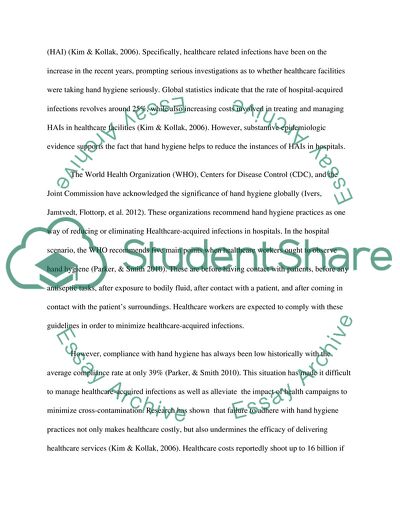
- Home
- Free Samples
- Premium Essays
- Editing Services
- Extra Tools
- Essay Writing Help
- About Us
- Studentshare
- Subjects
- Nursing
- Re-Educating Health Care Providers on Hand Hygiene Practice
Re-Educating Health Care Providers on Hand Hygiene Practice - Research Paper Example

- Subject: Nursing
- Type: Research Paper
- Level: Undergraduate
- Pages: 22 (5500 words)
- Downloads: 0
- Author: pmraz
Extract of sample "Re-Educating Health Care Providers on Hand Hygiene Practice"
Hand hygiene practices focus on cleansing hands using a wide range of medical substances or products such as antimicrobial soaps, antiseptic agents, detergents/surfactants, waterless antiseptic agents, plain soaps, antiseptic hand wipes, and alcohol-based rubs. Hand hygiene can be achieved through a wide range of practices including antiseptic hand washing, hand rubbing, decontamination, disinfection, hand antisepsis, surgical or pre-surgical hand antisepsis, and general hand care (Johnson, 2010). It is estimated that eight thousand patients often succumb to the HAIs and die while still undergoing treatment in the hospitals (Ivers, Jamtvedt, Flottorp, et al. 2012). Most of the existing literature shows a direct link between hand hygiene practices and the rates of healthcare-acquired infections (Glanz, Bishop, 2010). The main underlying factor is that compliance with hand hygiene practices reduces the rates of related infections to a greater extent. However, inadequacies exist in the literature available regarding how to increase compliance with hand hygiene practices before and after attending to each patient according to the guidelines stipulated by the WHO (Dennison & Prevost, 2012).
Thorough and proper hand hygiene is one of the most significant practices, which helps in eliminating cross-contamination and reducing incidences of hospital-acquired infections (HAI) (Kim & Kollak, 2006). Specifically, healthcare-related infections have been on the increase in recent years, prompting serious investigations as to whether healthcare facilities were taking hand hygiene seriously. Global statistics indicate that the rate of hospital-acquired infections revolves around 25%, while also increasing the costs involved in treating and managing HAIs in healthcare facilities (Kim & Kollak, 2006).
However, substantive epidemiologic evidence supports the fact that hand hygiene helps to reduce the instances of HAIs in hospitals. The World Health Organization (WHO), Centers for Disease Control (CDC), and the Joint Commission have acknowledged the significance of hand hygiene globally (Ivers, Jamtvedt, Flottorp, et al. 2012). These organizations recommend hand hygiene practices as one way of reducing or eliminating Healthcare-acquired infections in hospitals. In the hospital scenario, the WHO recommends five main points when healthcare workers ought to observe hand hygiene (Parker, & Smith 2010).
...Download file to see next pages Read MoreCHECK THESE SAMPLES OF Re-Educating Health Care Providers on Hand Hygiene Practice
Effective Hand Hygiene in Clinical Settings
Evidence for Professional Practice
Re-Educating Healthcare Providers
Re-Educating Healthcare Providers on Hand Hygiene Practice
The Effects Associated with Poor Hand Hygiene by Healthcare
Effect of Hand Hygiene Practice by Health Care Providers on HAI
Local Initiative Action Plan is Health Promotion
Health Policy Analysis on Hand Hygiene

- TERMS & CONDITIONS
- PRIVACY POLICY
- COOKIES POLICY